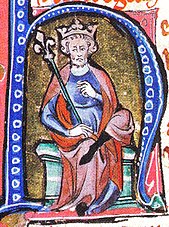Battle of Assandun

Edmund Eisseite (left) in a duel with Knut the Great. (Depiction from the Chronica Majora by Matthew Paris , around 1250)
| date | October 18, 1016 |
|---|---|
| place | Assandun, Essex, England |
| output | Victory of the Danes |
| Parties to the conflict | |
|---|---|
|
Denmark |
England (Anglo-Saxons) |
| Commander | |
| Troop strength | |
| unknown | unknown |
| losses | |
|
unknown |
unknown |
The Battle of Assandun occurred on October 18, 1016 in Assandun. To this day it is debatable whether Assandun is today's Ashdon or - as long assumed - Ashingdon in southeast Essex , England . The battle ended with a victory for the Danes, who fought under the leadership of Canute the Great . The English army was led by Edmund II . The battle marks the conclusion of the Danish conquest of England and the beginning of the Anglo-Scandinavian Empire under Canute's rule.
There were seven kingdoms in England in earlier times, but there were only two in the late 10th century. The Danes ruled two thirds of England - the Danelag , the area north of the Thames , along the Lee , northwest to and including the Midlands including eastern Mercia to Chester and the River Dee . The Saxons ruled the area south of the Thames, west of Wessex and west of Mercia.
Before the battle, King Canute had besieged London . Against the Saxon hierarchy he received significant support from the English nobility. The siege was a response to King Edmund's conquest of Wessex, which had been ruled by Danes, and several small but undecided clashes with Knut's army. London resisted the siege with the help of Edmund, but he lacked troops after the attack against the Danes in Mercia.
Edmund was forced to travel with his army through an area of land that was dominated by enemies. Here he was exposed to the constant risk of being attacked by Danish troops. Knut's scouts had noticed Edmund's advance, and in Essex, Edmund's army was intercepted by Canute. This surprise effect led some of Edmund's men to desert and a Danish superior force quickly dominated the battle. However, there are also sources that claim that the English army initially dominated, but would have been betrayed by Eadric Streona, who had reached an agreement with Canute to abandon the English army at the crucial moment.
After his defeat, King Edmund was forced to sign a treaty with Canute which gave Canute control over all English territories except Wessex. After Edmund's death, Wessex would also fall to the Danes. Accordingly, after Edmund's death, which occurred on November 30th of that year, Canute the Great was able to unite all of England under his rule.
After the victory, Knut built a memorial church in memory of his men who died in the battle. In 1020 the building called Ashingdon Minster was completed on the mountain next to the alleged battlefield. The church still exists today.
swell
Several chronicles from this period mention the battle. The Anglo-Saxon Chronicle briefly mentions the battle. It is also mentioned briefly in the Knýtlinga saga . The longest mention can be found in the Encomium Emmae Reginae , the price publication of the Emma of Normandy , with which the English queen wanted to justify the claims to the throne of Hardiknut , her son with Canute the Great.
literature
- Egon Wamers (ed.): The last Vikings. The Bayeux Tapestry and archeology. Archaeological Museum Frankfurt am Main, Frankfurt am Main 2009, ISBN 978-3-88270-506-5
